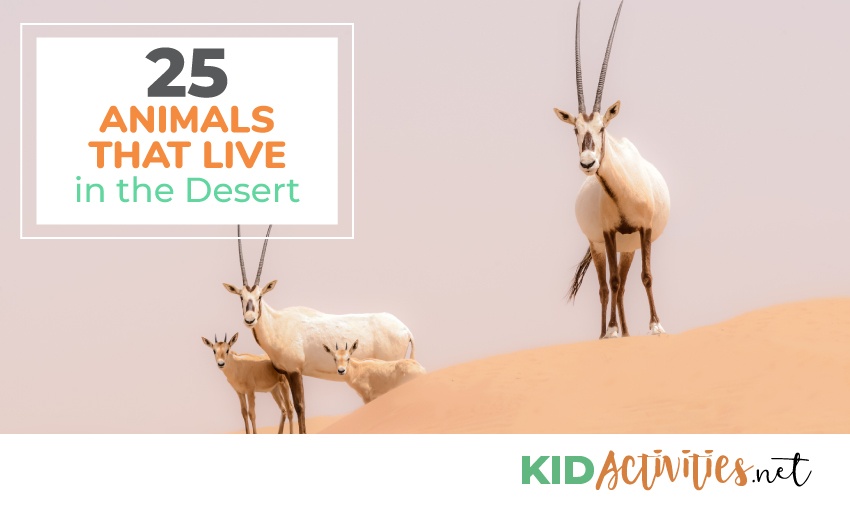The desert is home to a wide variety of impressive and varying creatures. From mammals to insects, reptiles and birds, and everything in between, the natural ecosystem preserved in desert environments is fascinating.
Desert animals are able to strike a delicate balance between the hunter and hunted, carnivores and herbivores, without entirely throwing off the balance of other creatures within the desert.
Many desert-dwelling creatures are versatile and easily adaptable. Found in many climates, the harsh conditions of the desert seemingly do not phase them.
Likewise, many birds (check out our bird games) mentioned below choose to migrate to the desert during the winter or have otherwise found unique ways to live in sparse water habitats within the desert.
Others prefer to move and graze, on the run from any natural predators choosing to stalk them. Some burrow beneath the sand and spend the majority of their lives this way.
Animals that live in the desert come in a wide variety of varying creatures but have one thing in common. They have found ways to adapt to the desert heat. What’s more, they mostly enjoy their lives away from human beings.
Some animals, like bats and dingos, are considered to be shy. While they may be found in human-populated areas, it is mostly in search of food. These animals are so versatile, you’ll have to read about them yourself!
Animals That Live in the Desert
1. Armadillo

In Spanish, Armadillo means “little armored one.” This is true of the armadillo, a small mammal with a shell entirely unique to this animal.
The armadillo diet consists mostly of bugs, small reptiles, plants, and fruit.
What Makes the Desert a Prime Location for the Armadillo?
Like many animals that live in the desert, armadillos love warm climates. Their low body fat percentage, coupled with their naturally low body temperature means armadillos face the possibility of death in colder environments.
They also love to dig burrows to bury themselves in and spend most of their day sleeping, making the desert sands their ideal napping spot.
2. Coyotes
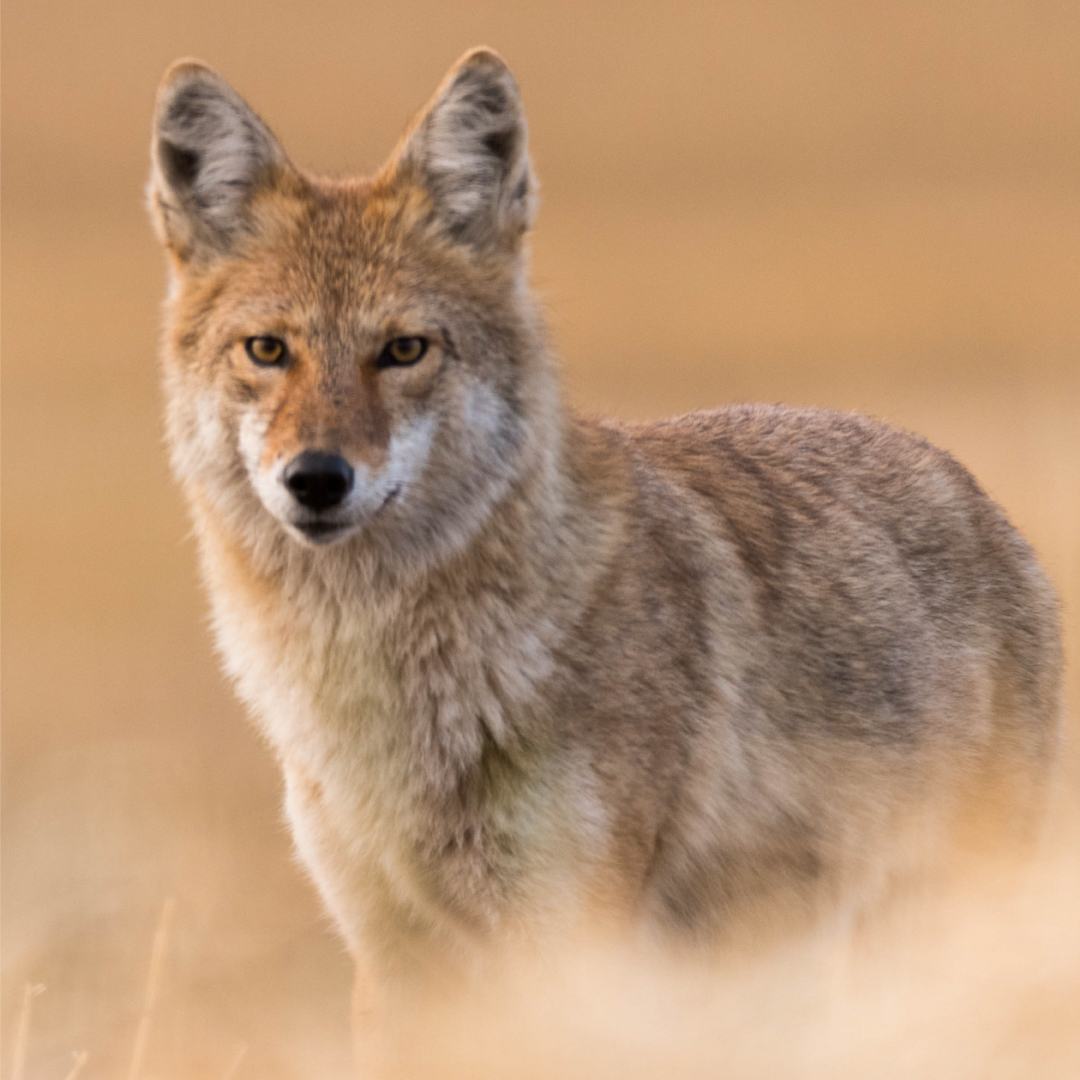
Physically, coyotes have a very similar appearance to small dogs, making them easily mistaken for the domesticated animal in the wild.
In reality, the coyote is an experienced and dangerous hunter, moving in packs to hunt prey. They are said to “sing” to their pack mates in order to communicate their location through their howls.
What Makes the Desert a Prime Location for Coyotes?
Coyotes are easily able to adapt to many different climates, the desert being one of them. Because their diet ranges from small rodents and mammals to reptiles, fish, birds, and more, the coyote is able to find plenty of prey within the desert.
The open plains of the desert, coupled with sparse vegetation for cover, provides the coyote with the perfect hunting conditions to stalk down prey.
3. Giraffe
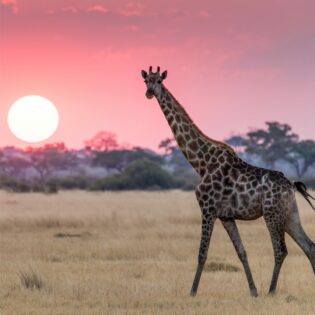
These gentle giants typically graze south of the Sahara Desert. Giraffes typically spend most of their days grazing for food. They mostly live off of Acacia leaves and require at least 10 gallons of water a day in order to survive. Because of this, giraffes mostly graze in loose formations, their entire herd spreading out across the savannah desert.
What Makes the Desert a Prime Location for Giraffes?
Most of the giraffe’s diet consists of Acacia leaves, which has contributed to their adapted, elongated necks made for reaching the tops of trees.
The rainy climate of the savannah allows the giraffe to thrive, along with the Acacia leaves that make up a majority of their diet.
4. Dingo
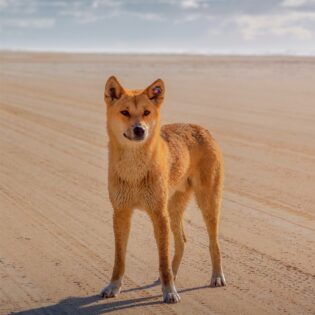
Unlike coyotes and other animals, Dingos are able to hunt either in packs or alone. The elusive animal is even more dog-like in appearance than the coyote, and their hunting habits tend to be more opportunistic. Dingos in Asia are even known to forage from humans!
What Makes the Desert a Prime Location for Dingos?
Dingos can be described as elusive, and tend to like more sparsely populated areas such as the desert because of this.
They can easily adapt to any climate, just as long as they have food, water, and shelter.
Some Australian sheepherders petitioned for a “dingo fence” to be built in the late 1800s, effectively isolating them from some more lush parts of Australia.
5. Wild Horses
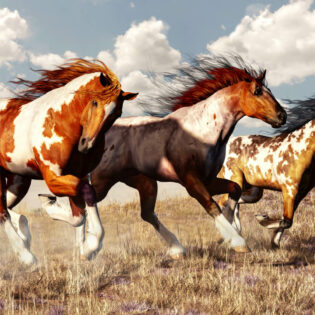
In America, wild horses have existed for millions of years. They are a part of the rich history of the Americas, from Native Americans to cowboy legends. Today, wild horses still roam free in the West, upholding the fable of the area.
What Makes the Desert a Prime Location for Wild Horses?
Horses must graze on grass and other plants in order to survive, as well as frequent water holes to stay hydrated. Wild horses are able to avoid harsh and dangerous slopes, preferring instead to stay on even ground.
6. Mountain Lion
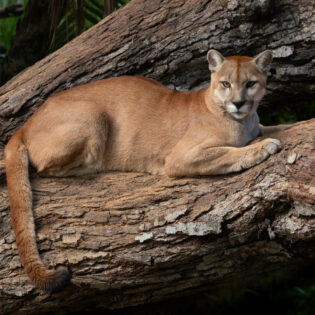
Mountain lions are largely nocturnal and predatorial. These are fast animals, preferring to ambush their prey utilizing bursts of speed to catch them off-guard and unable to defend themselves.
What Makes the Desert a Prime Location for Mountain Lions?
Mountain lions are adaptable to several different climates, and the desert is no different. They are able to utilize their tails in order to catch prey like deer and antelope, making desert denizens no problem for the mountain lion.
7. Bats
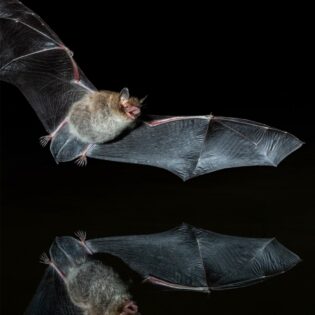
Different bats enjoy coming out at different times of day, with several types of bats emerging the day while others prefer dusk, dawn, or nighttime. Many breeds of bats could be considered animals that hibernates, making them difficult to spot in the wild entirely depending on the time of day and year you are looking for them.
What Makes the Desert a Prime Location for Bats?
Bats enjoy habitats far away from humans, making the desert close to ideal for them. They also mostly feed on insects and vegetation, easily found in the desert.
Several types of bats only require brief passage over small lakes or ponds in order to quench their thirst.
8. Camels
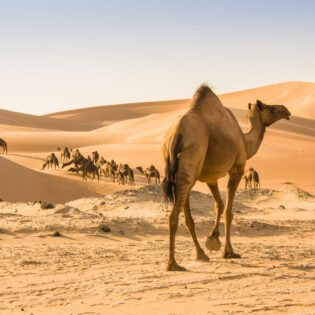
Famous for their humps, camels use them to store fat which can be broken down into drinking water. Camels are infamous as desert animals able to absorb amazing amounts of water in a short amount of time; up to 30 gallons in 13 minutes!
What Makes the Desert a Prime Location for Camels?
Because camels are so adept at storing water, they are able to survive long periods of time without rejuvenating. Likewise, they are able to survive extreme desert conditions and heat without sweating and losing water.
9. Jackrabbits
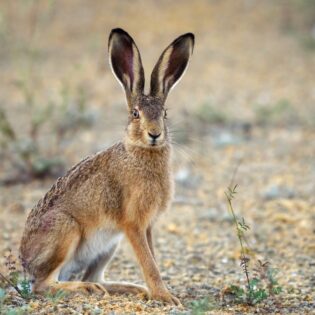
Jackrabbits come in both black-tailed and white-tailed varieties and are sometimes easily confused with one another. One need only check the underside of the rabbit’s tail in order to differentiate between the two.
What Makes the Desert a Prime Location for Jackrabbits?
As hares are vegetarians, they are able to survive off of a few varieties of brush and wild vegetation. White-tailed jackrabbits enjoy the wide, open plains the desert has to offer them.
10. Spiny Mouse

While the spiny mouse appears to be similar to a mouse in both appearance and name, the sping mouse is actually genetically closer to a gerbil, confounding scientists.
What Makes the Desert a Prime Location for the Spiny Mouse?
The spiny mouse is an omnivore, despite its small stature. The spiny mouse can survive off of small insects and plants alike. They favor arid climates, making the desert one of their most ideal living spaces.
11. Wolves
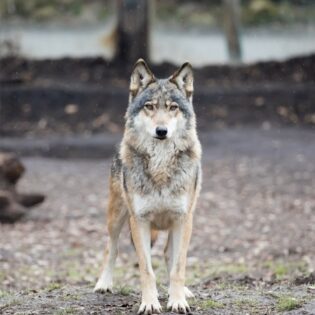
The desert wolf is one of the basest predators – a true carnivore, and a relative of domesticated canines! The wolf is truly the epitome of the hunter animal and predator, choosing to hunt down larger prey in packs.
What Makes the Desert a Prime Location for Wolves?
The desert provides a wide variety of large prey for desert wolves working together in packs. Led by the pack’s alpha, wolves are able to successfully hunt and prey upon larger desert animals.
12. Black Bears
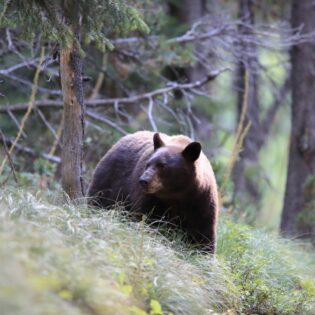
While these impressive creatures mainly stick to forest environments, they may be found in canyons during the summer and fall. Otherwise, they typically lightly hibernate during the winter and wouldn’t likely be found in the desert.
Oddly, in direct opposition to their name, not all black bears are black. They can widely vary in color and appearance.
What Makes the Desert a Prime Location for Black Bears?
Black bears have a wide and varied diet and are not picky eaters. Desert offerings of insects, grasses, roots, insects, and anything in between are enough to sustain a black bear, although they aren’t ones to turn their noses up at small desert prey.
13. Zebras
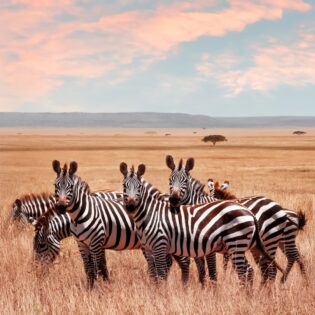
Zebras found in the desert are typically larger than their relatives in other regions. These zebras have amazing vision, with impressive sight both day and night.
What Makes the Desert a Prime Location for Zebras?
Zebras are built for desert survival. They mostly forage during the day, spending most of their waking hours ingesting what grasses and more they are able to uncover. Zebras readily drink water that is available to them but is able to survive days without water.
What’s more, these desert zebras are able to use their hooves to dig into the desert sand and dry river beds to find hidden sources of water in dire times of need.
14. Cooper’s Hawk
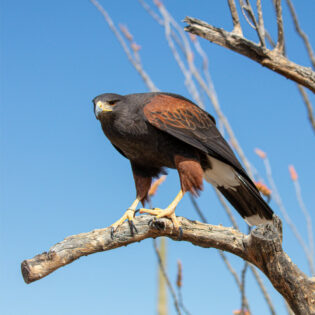
This bird of prey means serious business. While majestic to behold, this hawk is not easily approachable. A migratory bird, they are able to be located within the entire continental United States but are mostly found in deserts to the west.
With an impressive wingspan of up to 36 inches in females, the Cooper’s Hawk is a bird to behold when coming across it in person.
What Makes the Desert a Prime Location for the Cooper’s Hawk?
Cooper’s Hawks prefer to nest in desert cottonwood trees at a high elevation. The birds may also choose to nest in sycamores and oaks, but their nests largely remain the same. The hawk tends to remain nested and hunt when it is opportunistic for them, as true predators do.
15. Blue Heron
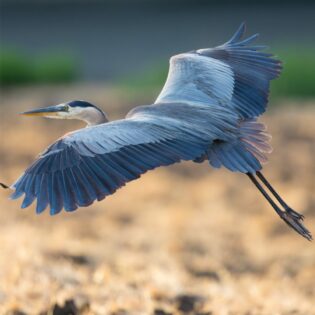
While the blue heron may seem majestic and stately, they are actually fiercely territorial and unafraid to defend themselves. These birds are both loud and verbal, using their caws to drive away would-be predators and human visitors alike.
What Makes the Desert a Prime Location for the Blue Heron?
While these herons exist across the United States, they tend to nest near to any available water. Although water may be sparse in certain desert regions, the blue heron is likely to find the water region that best suits their needs and drive away any potential predators.
16. Ostrich
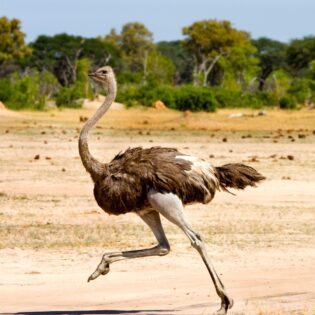
These flightless, two-legged birds may be the source of consternation from many. In actuality, the ostrich is able to claim the title of the fastest two-legged bird. Males of the species can grow up to a whopping 350 pounds – one most likely wouldn’t want to be chased down by an ostrich in a bad mood!
What Makes the Desert a Prime Location for the Ostrich?
While the desert is rife with natural predators to the ostrich, their speed allows them to outrun them easily. Their legs are more than fast. In some cases, they can be lethal. In some cases, ostriches have been known to take down even a lion with their powerful legs.
An omnivore, the ostrich pretty much eats whatever it can find in the environment around it, making it easily adaptable to desert life.
17. Plains Bison
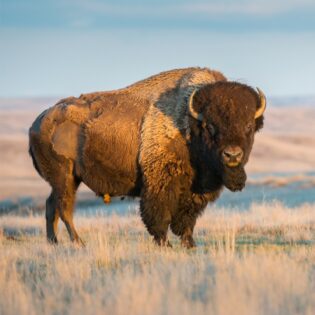
These bison are sturdy. Having lived through the Ice Age and more, they are truly remarkable creatures to behold – as if even beholding such an ancient creature isn’t impressive enough. They weigh up to 2000 pounds, and like the previously mentioned ostrich, run up to 40 miles per hour.
What Makes the Desert a Prime Location for the Plains Bison?
Plains bison migrate and move around intuitively in order to avoid over-grazing. The desert’s sparse vegetation provides the perfect grazing habitat to the plains bison, as they don’t have to worry about moving too much, too often.
18. Great Horned Owl
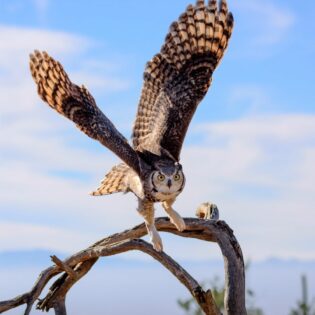
Like many owls, the great horned owl hibernates during the day. At night, their superior eyesight allows them to survive in the dark. Coupled with their impressive hearing, great horned owls easily avoid predators. Impressive themselves, they are able to fly noiselessly and hunt prey during the night.
What Makes the Desert a Prime Location for the Great Horned Owl?
Great horned owls exist across the continental United States but tend to migrate south like many birds during the winter. Great horned owls are better suited to the arid weather than the cold.
19. Loon
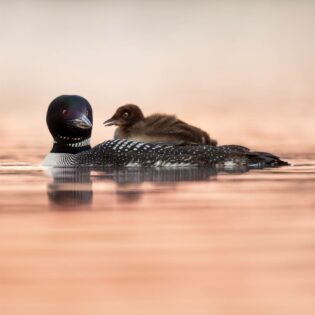
The loon is a forager and often dives underwater in order to look for prey. Able to open their eyes while underwater and scan for their next potential meal, the desert loon is a sight to behold when engaging in its natural predatory behavior.
What Makes the Desert a Prime Location for the Loon?
While many loons make their home in rivers and larger bodies of water, they are happily able to make themselves at home in shallow bodies of water provided they have enough shade and fish to feed on.
20. Snowy Egret
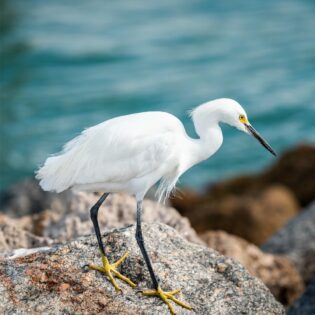
The snowy egret is a delight to behold. These egrets truly enjoy showing off what natural beauty and majesty they have. Natural entertainers, their natural curvatures and movements are carefully calculated.
What Makes the Desert a Prime Location for the Snowy Egret?
During the off-breeding season, the snowy egret is not particularly picky about where it makes its nest. What’s more, they are naturally diverse in their eating habits. A snowy egret will eat just about anything it has to in order to survive, making it well suited to the unpredictability of desert climates.
21. Ospreys
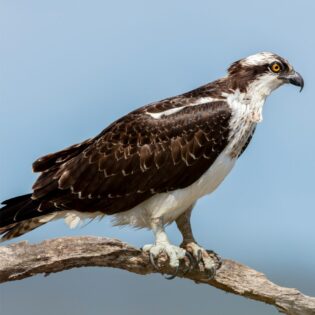
The osprey is highly elusive. The bird spends an impressive amount of its lifetime in flight, changing habits often and in an adaptable fashion. Because they are so well-traveled, ospreys are not often picky about where they make their nests, sometimes even making their nests on the ground when they are not immediately threatened by prey.
What Makes the Desert a Prime Location for Ospreys?
Their adaptability makes them well-suited to many climates. Because they will likely be moving on anyway, many ospreys spend their time in the desert without settling down for long.
Like many aforementioned desert birds, their diets are versatile and well-suited to desert areas.
22. Gila Monster
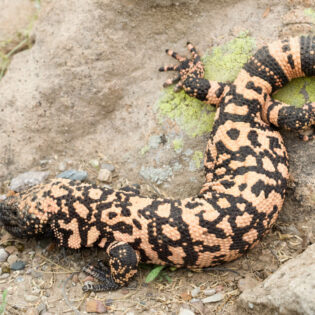
These poisonous lizards are ready to defend themselves against predators but rarely prove to be lethal to humans. They are, however, easily able to fend off potential predators.
What Makes the Desert a Prime Location for the Gila Monster?
Gila monsters enjoy the shrubs and arid climate found in the desert, as well as burrowing. Gila monsters will adopt another animal’s burrow to suit them or dig themselves into holes in the sand.
Gila monsters feed on smaller animals in the summer and store excess fat for usage in the winter.
23. King Cobra
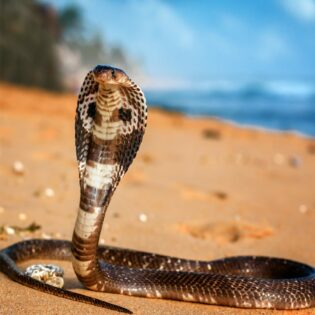
This snake is highly venomous and earns its royal title in this way. Slithering gracefully across the desert, one does not want to mess with this all-powerful and impressive predator.
What Makes the Desert a Prime Location for the King Cobra?
King Cobras enjoy inhabiting small bodies of water in the deserts of southeast Asia, preying upon smaller snakes. In this habitat, the King Cobra likely faces no natural predators. While their eggs may prove to be vulnerable, a fully grown cobra can intimidate almost any other creature with which it comes into contact within the desert.
24. Desert Tortoise
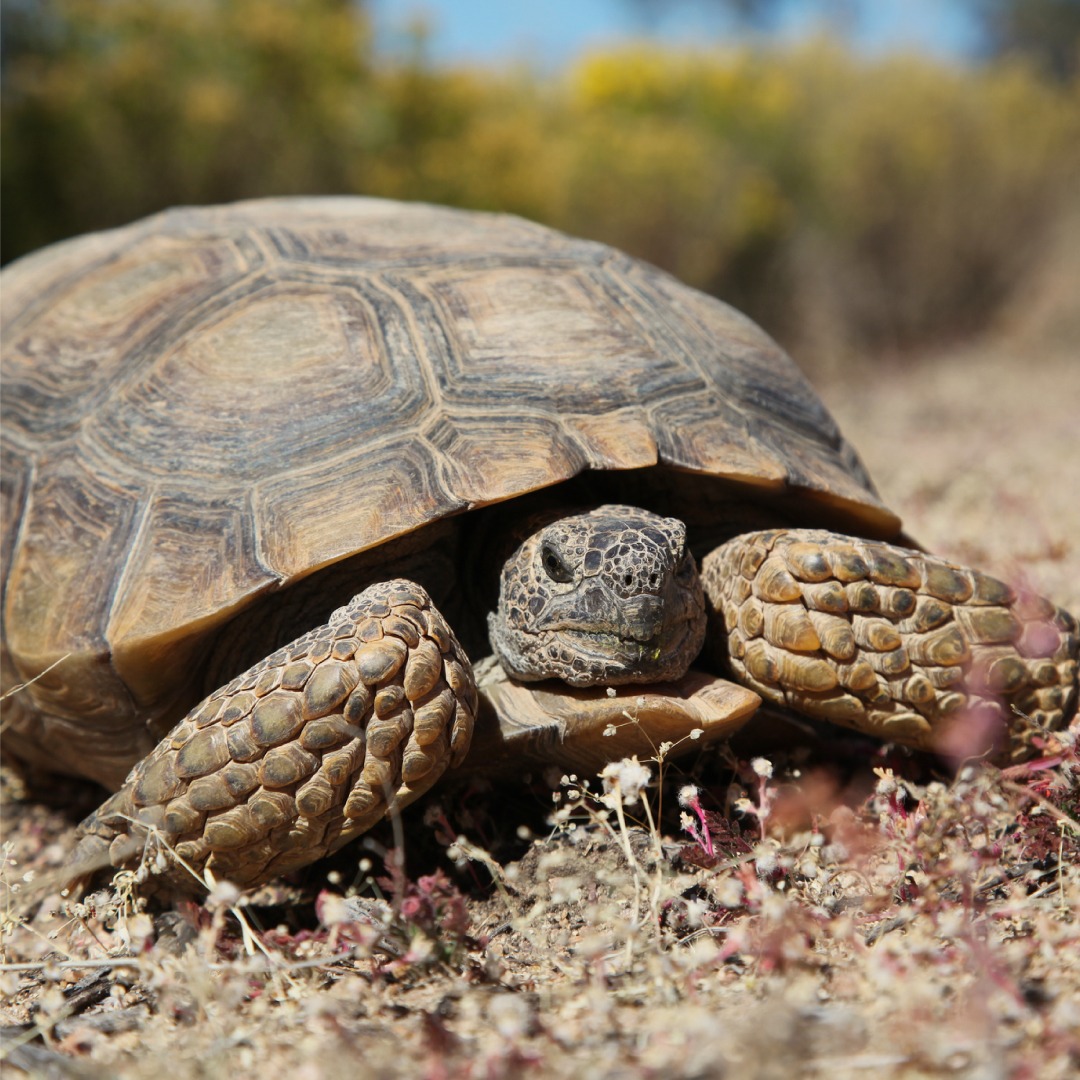
These desert tortoises are distantly related to land-dwelling turtles. These domed relatives are unable to swim, instead designed for life on land and below it.
What Makes the Desert a Prime Location for the Desert Tortoise?
Desert tortoises are able to live in temperatures over 140 degrees Fahrenheit because they are able to dig themselves under the sand to easily escape the heat. In fact, the desert tortoise spends a majority of its life under the sand.
25. Scorpions
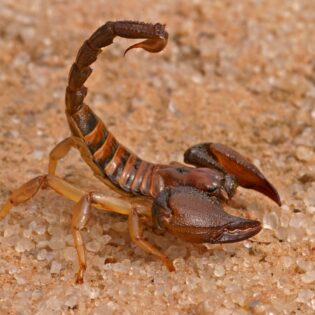
Yet another poisonous desert creature, the scorpion is typically not poisonous enough to prove to be lethal to human beings. Crablike, these invertebrates possess pincers and stingers with which they are able to defend themselves from natural predators.
What Makes the Desert a Prime Location for Scorpions?
Scorpions prefer climates that are dry and warm, thriving in southern desert climates of the United States.
They are naturally nocturnal and able to spend a majority of their time burrowed under the sand. Easily adaptable, the scorpion has adapted to numerous climates and found a way to thrive.
26. Bobcats
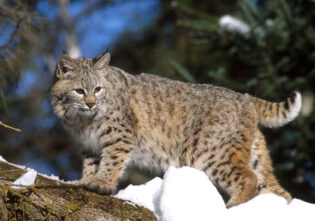
Native to North America, the Bobcat can also be known as the Red Lynx is a medium size cat that also loves to live in the desert.
Due to its large population ( considering ) it is listed as ” least concern ” on the endangered animals list.
Why is the desert a good place to live for the Bobcat?
Like a lot of other desert animals, the Bobcat prefers the hot climate, and also the coat colors which are naturally brown and red in color blends well in the desert sand.
Fun fact about Bob cats is that they are really fast, and can run in speeds of up to 30 miles per hour.
Conclusion
The desert is home to such a wide variety of animals one would be hard-pressed to find a defining characteristic of them all.
Deserts around the world vary in the types of animals they offer. However, it is certain that as a visitor, you will be sure to easily find a species or two that will impress you if you decide to take a trip out to the desert yourself!
Want some more great animal articles? Check out our animal-themed games and our post on animals that start with the letter N.
